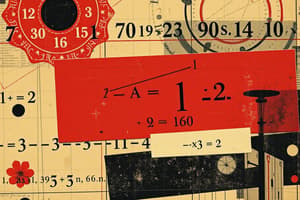Podcast
Questions and Answers
Flashcards
Var Model
Var Model
A visual tool using rectangles to represent equations, aiding in solving for unknowns.
Literal Coefficient
Literal Coefficient
The letters (variables) present in a term.
Numerical Coefficient
Numerical Coefficient
A number that multiplies a variable in a term.
Evaluating Algebraic Expressions
Evaluating Algebraic Expressions
Signup and view all the flashcards
Algebraic Expression
Algebraic Expression
Signup and view all the flashcards
Variable
Variable
Signup and view all the flashcards
Transposing in Equations
Transposing in Equations
Signup and view all the flashcards
Addition Property of Equality
Addition Property of Equality
Signup and view all the flashcards
Symmetric Property of Equality
Symmetric Property of Equality
Signup and view all the flashcards
Literal Equation
Literal Equation
Signup and view all the flashcards
Solving Literal Equations
Solving Literal Equations
Signup and view all the flashcards
Word Sentences to Algebraic Expressions
Word Sentences to Algebraic Expressions
Signup and view all the flashcards
Algebraic Expressions to Word Sentences
Algebraic Expressions to Word Sentences
Signup and view all the flashcards
Study Notes
Var Model and Equations
- The var model helps visualize equations with rectangles or vars.
- Analyze all choices in "not belong to the group" questions.
- Equations include an equal sign, while expressions do not.
Solving Equations with Var Model Example
- To solve 2x - 6 = 4 using the var model: represent 2x with a rectangle, place -6 below it, and match with 4 below.
- Combining 4 and 6 yields 10, leading to 2x = 10.
- Divide x into 2 equal parts.
- Since x + x = 2x, split 10 into two equal parts: 5 and 5.
- Therefore, x = 5.
Var Model Descriptions and Algebraic Expressions
- When using the var model for x + 5 = 8, place vars x and 5 at the top and 8 at the bottom.
- A variable is a symbol or letter representing an unknown value in an algebraic expression.
Coefficients
- The literal coefficient refers to letters in a term.
- A numerical coefficient is a number.
- In the expression 3xy, xy is the literal coefficient.
Mathematical Phrases and Algebraic Expressions
- When identifying which mathematical phrase doesn't belong in a group, check if the exponent in each letter is a whole number.
- Polynomials have whole number exponents.
Evaluating Algebraic Expressions
- Substitute a value for each variable to evaluate an algebraic expression.
- Evaluate 2m + 3n by substituting m = 4 and n = 2 to get 2(4) + 3(2) = 8 + 6 = 14.
- To evaluate 2x + 9 when x = 10, compute 2 * 10 + 9, which equals 29.
Translating between Algebraic Expressions and Word Sentences
- The phrase can be a verbal phrase or an algebraic expression.
- "The quotient of twice a number and 11" translates to 2x / 11.
- "3 times a number greater than 8" translates to 3y + 8.
- The algebraic expression x - 10 translates to "10 less than a number."
Properties of Equality (Solving Equations)
- Moving a "+ number" to the other side of an equation requires subtracting it from both sides.
- The addition property of equality involves adding the same number to both sides of the equation.
- The symmetric property of equality allows interchanging the left and right sides of an equation.
- If x = 5, then 5 = x, illustrating the symmetric property.
Solving for a Variable
- A literal equation involves two or more variables, with one variable solved in terms of the others.
- Solve one variable in terms of the other to find a literal equation.
- To solve for length (L) in A = LW, divide both sides by W to get L = A / W.
- To solve for height in A = 1/2 * base * height, first remove 1/2.
- Multiply both sides by 2, resulting in 2A = base * height.
Complex Equations and Problem Solving
- To solve 2m + 3n = y for m, transpose 3n: 2m = y - 3n, then divide by 2: m = (y - 3n) / 2.
- To solve 2 + x = y - 7 in terms of y, transpose -7: 2 + x + 7 = y, simplify: y = x + 9.
Studying That Suits You
Use AI to generate personalized quizzes and flashcards to suit your learning preferences.




